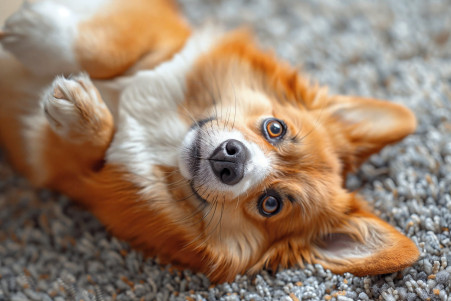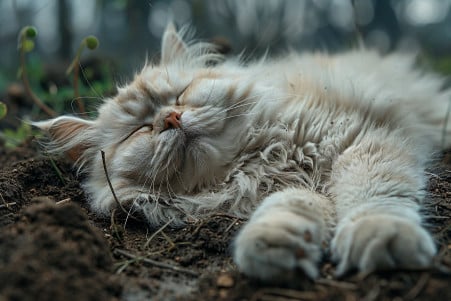Why Do Dogs Roll in Dead Things? Theories From Science
5 April 2024 • Updated 5 April 2024

If you've ever found yourself asking why your beloved pet insists on rolling in the stench of rotting, dead animals, you're not alone. Dogs rolling in dead things is a natural behavior that dates back to their ancestors' need to mask their own scent - a survival tactic for early hunters trying to avoid detection. It's also a way to convey information about an animal's location, social rank, and territory through scent marking.
While it may be hard to believe, this behavior is hardwired into dogs and has roots in evolution that we'll take a closer look at. We'll also cover studies from animal behaviorists and biologists that have investigated the origins of this strange behavior. By learning about the science of scent-rolling, you'll be able to tap into your dog's primal instincts and make more sense of this strange, but fascinating, behavior.
Why do dogs roll in dead animals?
The Evolutionary Psychology Behind Scent-Rolling
Scent-rolling likely evolved as a survival tactic for wild canines to mask their scent while hunting prey. According to Psychology Today, the prevailing theory is that coating themselves in pungent odors like animal carcasses or feces allowed wolves and other wild dogs to sneak up on unsuspecting prey without being detected by their powerful sense of smell.
This scent camouflage was an adaptive behavior that increased hunting success, as noted by researchers studying the evolutionary significance of scent communication in canines. By disguising their predator odor, wild dogs could get close enough to potential prey to launch a successful ambush.
However, scent-rolling served another vital purpose - facilitating information sharing within the pack. Studies suggest rolling in strong smells allowed pack members to signal the location of food sources, territory boundaries, and other resources to one another through scent marking. This olfactory communication was essential for coordinating the social and survival behaviors of tightly-knit canine families.
While our domesticated pets no longer require hunting prowess, the deep-seated urge to roll in pungent, decaying smells persists as an evolutionary holdover. These innate behaviors, once crucial for wild canine survival, now manifest as seemingly bizarre tendencies that baffle modern dog owners. Understanding the evolutionary psychology behind scent-rolling provides insight into your pup's primal instincts.
Health Risks: Diseases Dogs Can Get from Dead Animals
Rolling in dead animal carcasses can mean dogs are exposed to a number of harmful bacteria, viruses, and parasites. According to UrgentVet, this can include leptospirosis, toxoplasmosis, salmonella, and parasitic infections such as mange. Dogs can also get foodborne illnesses like botulism from eating decaying animal remains, which can cause sudden paralysis.
As mentioned by Dogster, rolling in the smell of dead animals can also mean dogs are exposed to parasites and diseases that can make them sick. The bacteria in decomposing organic matter can be harmful, even if there are some potential immune system benefits.
Palmetto Wild Life Extractors explains that dead animals can carry a number of parasites like mites, fleas, and ticks that can attach to pets and transmit other diseases like Lyme disease, typhus, and even the bubonic plague. Quick cleaning and veterinary attention are important to avoid more serious health problems after coming into contact with dead animals.
How to Stop and Prevent Scent-Rolling: Training Techniques
According to BetterPet, a strong recall is the most important training technique for getting dogs to leave dead animals. Since reward-based training has been shown to be more effective and is now recommended by both dog trainers and veterinarians, it is the best way to train dogs and also helps to strengthen the bond between dogs and their humans.
In addition, keeping dogs on a leash and regularly checking yards for dead animals can help prevent exposure, according to Good Housekeeping. If a dog does roll in a dead animal, it's best to bathe them immediately with a deodorizing shampoo. Leaving the shampoo on for up to 10 minutes can help it penetrate the coat and remove the smell.
As That Dog Guy points out, you can't tell a dog what not to do, you have to show them what to do. However, with consistent positive reinforcement and a watchful eye, dog owners can work to minimize the risks of this behavior while still honoring their dog's natural instincts.
Scent in Canine Communication and Social Dynamics
Dogs use their sense of smell to communicate and interact with other members of their pack. The American Kennel Club suggests that scent-rolling helps dogs communicate information about resources, territory, and social status to other dogs. By rolling in the scent of dead animals or other strong-smelling substances, dogs can let other members of their pack know what they've found and show that they're in charge.
This could also be a form of "scent bragging," as researchers at Wolf Park have seen wolves follow a scent to its origin to find resources, such as food. Meanwhile, some breeds or individual dogs may be more prone to scent-rolling due to genetic and environmental factors, according to the Whole Dog Journal. This knowledge can help us better understand the complex pack behavior and communication of our dogs.
What Scent-Rolling Means and How to Deal With It
Dogs rolling in smelly things is a way to gather scents, and it's a form of communication. Dogs are focusing on the scents they gather around their faces and necks, and this is a way of communicating with other dogs, who also sniff around the head and shoulders when they greet other dogs. This is a form of communication that's similar to the way wolves communicate, according to the Gentle Beast Dog Training Blog.
Patricia McConnell doesn't believe the scent-masking hypothesis is very likely, and she points out that the senses of prey animals are so acute that if they can smell a predator coming, they can smell a predator coming, no matter what other smells are mixed in. This is also noted by the Whole Dog Journal.
While scent-marking is a common behavior in mammals, dogs don't seem to be rolling in smelly things to mark their territory, so this hypothesis can be ruled out, according to the Gentle Beast Dog Training Blog.
Pat Goodman, the curator of Wolf Park in Indiana, has studied scent rolling in wolves and believes that it's a form of information sharing. When wolves roll in a scent, they bring it back to their pack, and the other members of the pack will sniff the wolf and then follow the scent back to its source, as Cattledog Publishing explains.
Rolling around may trigger a rush of dopamine, the neurotransmitter responsible for pleasure and reward signals. The behavior may have its roots in all sorts of evolutionary reasons, but it persists in our pets because it feels good, according to Whole Dog Journal.
Concluding Insights: Understanding Canine Behavior and Its Origins
While the behavior may be unpleasant to humans, scent-rolling is a natural and deeply rooted behavior in dogs. It likely served important survival and communication functions in the wild.
Even though dogs have been domesticated, they still show many instinctual behaviors that are rooted in their wild ancestors. With proper training, environmental management, and veterinary care, pet owners can minimize risks while respecting their dog's innate nature.


